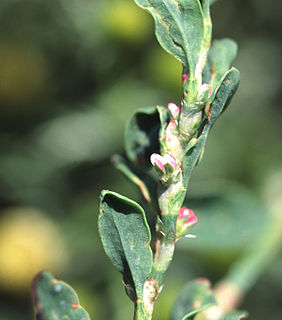
Polygonum arenastrum, commonly known as equal-leaved knotgrass, is a summer annual flowering plant in the knotweed family Polygonaceae. Other common names include common knotweed, prostrate knotweed, mat grass, oval-leaf knotweed, stone grass, wiregrass, and door weed, as well as many others. It is native to Europe and can be found on other continents as an introduced species and a common noxious weed. Knotweed was first seen in North America in 1809 and is now seen across much of the United States and Canada.
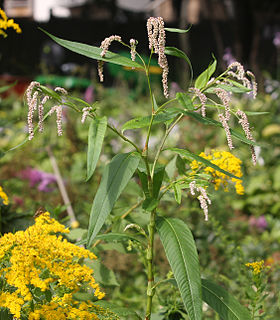
Persicaria lapathifolia, known as pale persicaria, is a plant of the family Polygonaceae. It is closely related to Persicaria maculosa and as such is considered a weed in Britain and Europe. Other common names for the plant include pale smartweed, curlytop knotweed, and willow weed. It is a species complex made up of a great many varying forms, sometimes considered varieties. The environment also has a strong influence on the morphology of an individual plant.
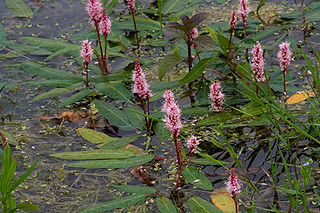
Persicaria amphibia is a species of flowering plant in the knotweed family known by several common names, including longroot smartweed, water knotweed, water smartweed, and amphibious bistort. It is native to much of North America, Asia, Europe, and parts of Africa, and it grows elsewhere as an introduced species and sometimes a noxious weed.
Polygonum bidwelliae is an uncommon species of flowering plant in the knotweed family known by the common name Bidwell's knotweed. The plant was named for American suffragist Annie Bidwell, who at one time lived in the Bidwell Mansion in Chico, California. She is the person who collected the type specimen in Northern California.
Polygonum bolanderi is an uncommon California species of flowering plant in the buckwheat family known by the common name Bolander's knotweed.
Polygonum californicum is a species of flowering plant in the buckwheat family known by the common name California knotweed. It is native to the west coast of the United States from Washington, Oregon, and northern and central California in the Coast Ranges and Sierra Nevada foothills as far south as Napa and Tulare Counties. It can be found in many types of open habitats.
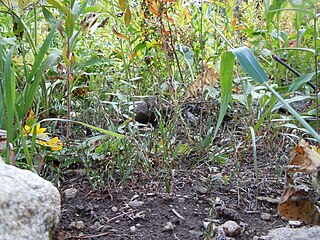
Polygonum douglasii is a species of flowering plant in the knotweed family known by the common name Douglas's knotweed. It is native to much of northern and western North America, where it can be found in many types of habitat, including disturbed areas. It has been found in Canada from British Columbia north to Yukon and east as far as Québec, and in the United States as far south as California, New Mexico, Iowa, and New York.
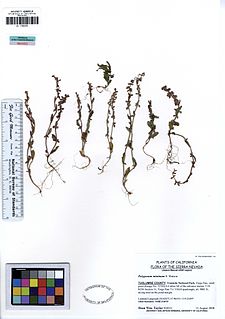
Polygonum minimum is a species of flowering plant in the knotweed family known by the common name broadleaf knotweed. It is native to much of western North America where it can be found in mountainous regions. It grows in the subalpine and alpine climates of high mountain ranges from Alaska to Arizona and New Mexico.
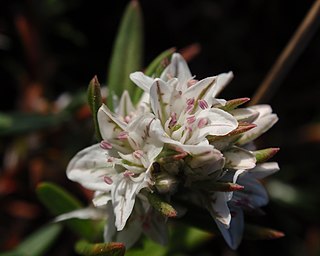
Polygonum paronychia is a species of flowering plant in the knotweed family known by the common names dune knotweed, black knotweed, and beach knotweed. It is native to the coastline of western North America from British Columbia to California, where it grows in sandy coastal habitat such as beaches, dunes, and scrub.
Polygonum parryi is a species of flowering plant in the knotweed family known by the common names Parry's knotweed and prickly knotweed. It is native to the western United States from Washington to California, where it grows in several types of moist, open habitat in mountainous and coastal areas.

Polygonum polygaloides is a North American species of flowering plants in the buckwheat family known by the common names milkwort knotweed and polygala knotweed. It is native to much of western North America, where it can be found in many types of moist habitat. It is a variable species, usually divided into a number of subspecies.

Persicaria punctata is a species of flowering plant in the knotweed family known by the common names dotted smartweed and dotted knotweed.
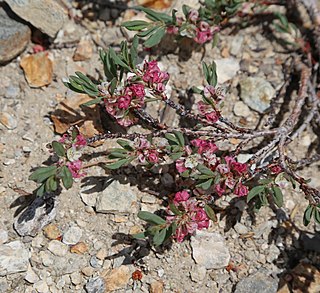
Polygonum shastense is a species of flowering plant in the knotweed family known by the common name Shasta knotweed. It is native to sections of southwestern Oregon, northwestern Nevada, and northern and central California, where it grows in rocky and gravelly mountainous habitat up to 3300 meters (11,000 feet) elevation. It is most common in the Sierra Nevada. The species name refers to its occurrence on Mount Shasta in Shasta County, California.
Tripterocalyx crux-maltae is a species of flowering plant in the four o'clock family known by the common names Lassen sandverbena and Kellogg's sand-verbena.
Polygonum hickmanii is a rare species of flowering plant in the buckwheat family known by the common names Scotts Valley polygonum and Hickman's knotweed. It is endemic to Santa Cruz County, California, where it is known from only two sites in the Scotts Valley. It grows on coastal prairie on mudstone and sandstone substrates, in an area known for its spring wildflowers. The small plant was first noted in 1990 and described as a new species in 1995. The plant is a federally listed endangered species.

Polygonum basiramia is a rare species of flowering plant in the knotweed family known by the common names wireweed, hairy wireweed, purple wireweed, and Florida jointweed. It is endemic to Florida in the United States, where it is limited to the central ridges of the peninsula, including the Lake Wales Ridge. It is threatened by the loss and degradation of its habitat. It is a federally listed endangered species of the United States.
Polygonum smallianum is a species of flowering plant in the knotweed family known by the common name largeleaf jointweed. It is native to a small area around the border between Alabama and Florida in the United States.
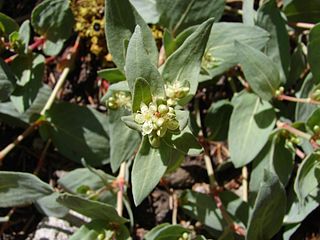
Koenigia davisiae is a flowering plant in the knotweed family that is known by the common names Davis' knotweed or Newberry knotweed.

Koenigia phytolaccifolia is a species of flowering plant in the knotweed family, known by the common name poke knotweed.
Polygonum majus is a North American species of flowering plant in the buckwheat family known by the common name wiry knotweed. It grows in the western United States and western Canada, from British Columbia south as far as the Sierra Nevada of northwestern Inyo County in California, east as far as Montana. Knotweed is a spreading, wiry annual weed that rarely grows higher than a few inches. The leaves are tiny, oblong, bluish-green, and 14 inches broad and 1 inch long. The flowers are tiny and unobtrusive, whitish-green in colour, and appear in the leaf axils in the fall. Knotweed may grow into a dense mat with a diameter of up to three feet, strangling out ideal grass and plants. The branches of this evergreen plant form a strong, wiry mat that reaches barely a few centimeters above the earth. They appear constantly, and gardeners are always fighting them. We cultivate the soil by tilling and enriching it. We plant our flowers and veggies, but the weeds make the most of our efforts. We believe we've got situation under control, but then we walk around to discover different things growing where we didn't expect it: knotweed sprawls down our walkways and up between our patio's paving stones.












